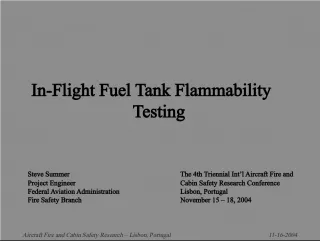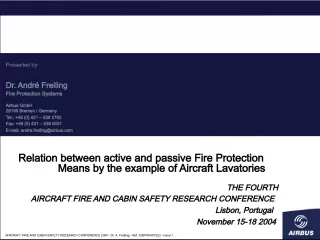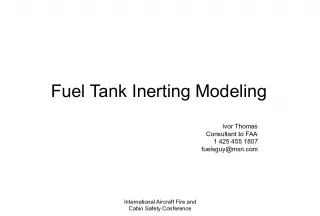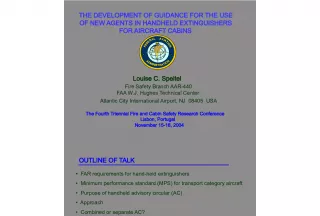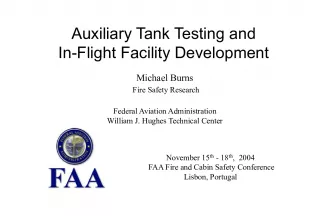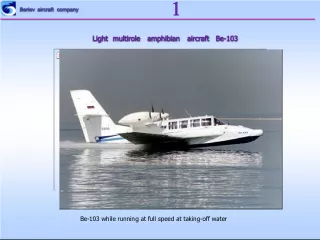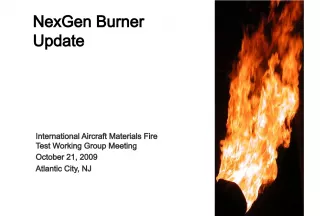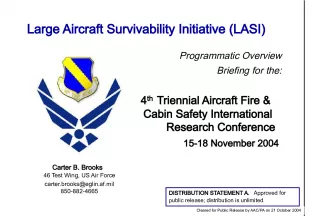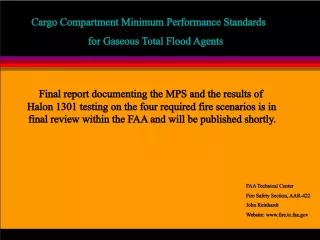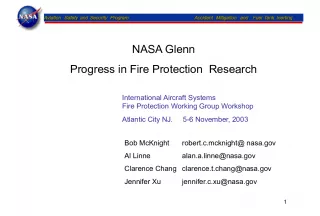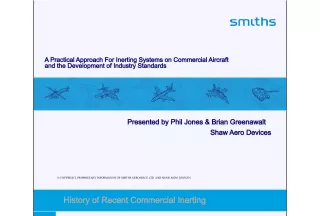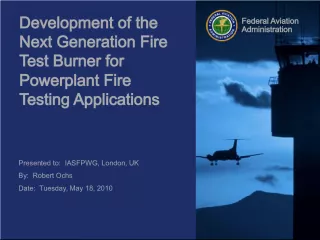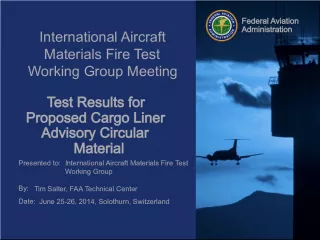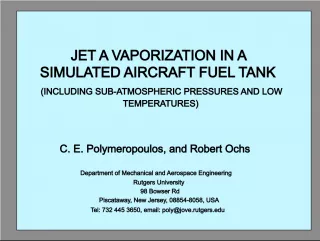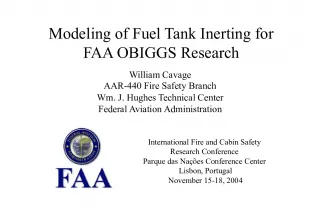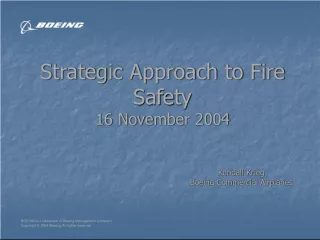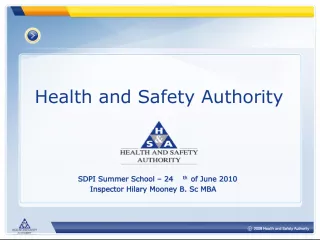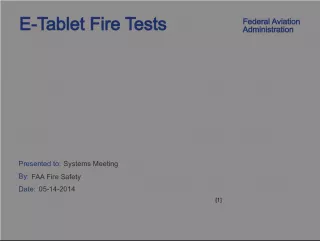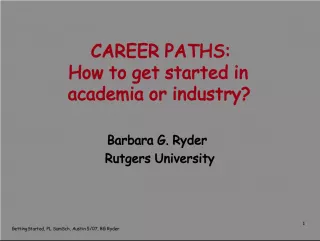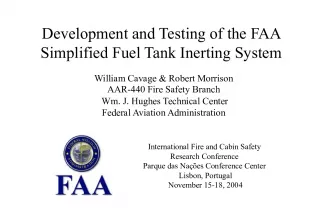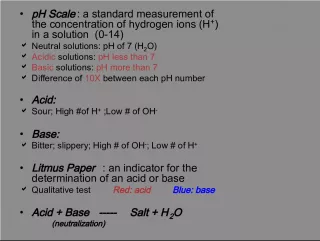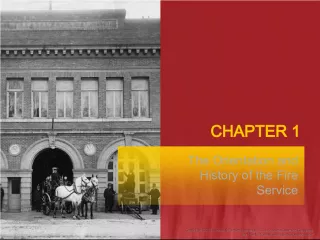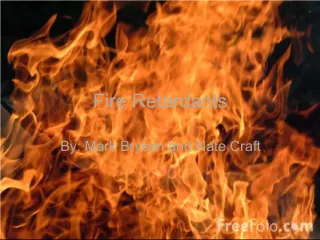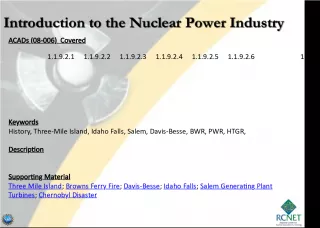Hydrogen Applications in the Aircraft Industry: Aircraft Fire and Cabin Safety Research Conference
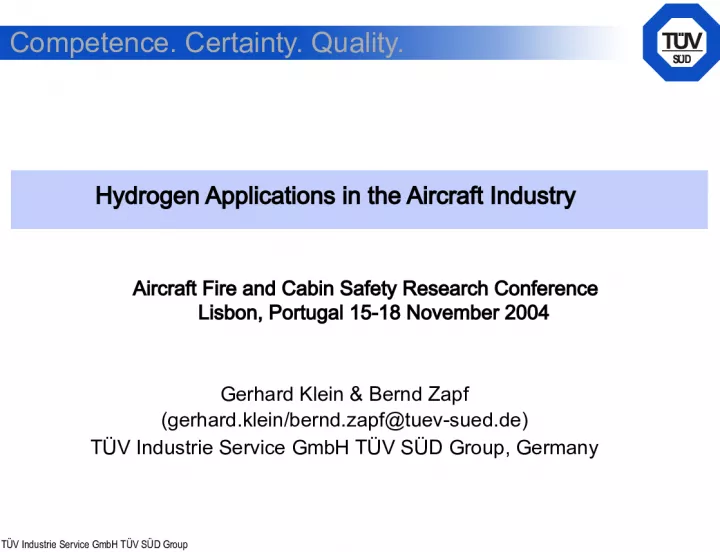

The T V Industrie Service GmbH T V S D Group presented their expertise on hydrogen application in the aircraft industry at the Aircraft Fire and Cabin Safety Research
- Uploaded on | 3 Views
-
 ratnakarnair
ratnakarnair
About Hydrogen Applications in the Aircraft Industry: Aircraft Fire and Cabin Safety Research Conference
PowerPoint presentation about 'Hydrogen Applications in the Aircraft Industry: Aircraft Fire and Cabin Safety Research Conference'. This presentation describes the topic on The T V Industrie Service GmbH T V S D Group presented their expertise on hydrogen application in the aircraft industry at the Aircraft Fire and Cabin Safety Research. The key topics included in this slideshow are . Download this presentation absolutely free.
Presentation Transcript
Slide1TÜV Industrie Service GmbH TÜV SÜD GroupCompetence. Certainty. Quality. Hydrogen Applications in the Aircraft Industry Gerhard Klein & Bernd Zapf (gerhard.klein/bernd.zapf@tuev-sued.de) TÜV Industrie Service GmbH TÜV SÜD Group, Germany Aircraft Fire and Cabin Safety Research Conference Lisbon, Portugal 15-18 November 2004
Slide2TÜV Industrie Service GmbH TÜV SÜD GroupAircraft Fire and Cabin Safety Research Conference Lisbon, Portugal 15-18 November 2004 Contents • Basic Properties of Hydrogen and its Application for Aircrafts • Basic Aspects of Risk and Safety • Automotive Industry • Tolerable Risk Targets for Hydrogen in the Aircraft Sector • Implementation of Risk Strategy
Slide3TÜV Industrie Service GmbH TÜV SÜD GroupAircraft Fire and Cabin Safety Research Conference Lisbon, Portugal 15-18 November 2004 Conventional Aircraft Power Architecture Aircraft Power Sources Aircraft Main Power Consumers
Slide4TÜV Industrie Service GmbH TÜV SÜD GroupAircraft Fire and Cabin Safety Research Conference Lisbon, Portugal 15-18 November 2004 Some properties of hydrogen and other fuels g = gaseous l = liquid Vapor density 0.55 3.2-4 7 1.56 about 1.5 1.4 0.09 relative to air Methane Gasoline Diesel fuel Propane Kerosene Methanol Hydrogen (g) (l) (l) (g) (l) (l) (g) Flammability limit (Vol.%) 5-16 0.6-8 0.6-6.5 2-10 0.6-7.0 6-36.5 4-75 Ignition temperature (°C) 595 220-280 220 460 about 500 455 585 min. ignition energy (mJ) 0.3 0.24 ./. 0.26 about 0.16 0.14 0.02
Slide5TÜV Industrie Service GmbH TÜV SÜD GroupAircraft Fire and Cabin Safety Research Conference Lisbon, Portugal 15-18 November 2004 Hydrogen – Current Applications
Slide6TÜV Industrie Service GmbH TÜV SÜD GroupAircraft Fire and Cabin Safety Research Conference Lisbon, Portugal 15-18 November 2004 Hydrogen Technology for Aerospace Combustion Engine Fuel Cell as APU Fuel Cell in space Apollo
Slide7TÜV Industrie Service GmbH TÜV SÜD GroupAircraft Fire and Cabin Safety Research Conference Lisbon, Portugal 15-18 November 2004 Fuel cells for Aircrafts – Why? More efficient power supply - due to FC technology Low emissions - significant NOx reduction on ground and in flight Low noise - excellent potential for significant on ground noise reduction Fuel economy - up to 75% Fuel Reduction on ground - about 30% Fuel Reduction in flight Heat production Water production
Slide8TÜV Industrie Service GmbH TÜV SÜD GroupAircraft Fire and Cabin Safety Research Conference Lisbon, Portugal 15-18 November 2004 Fuel Cells as Auxiliary Power Systems Performance evaluation shows two favorable fuel cell processes for aircraft applications: • Proton Exchange Membrane Fuel Cell – PEMFC • Solid Oxide Fuel Cell – SOFC T 60°C – 80°C T 800°C – 1000°C O 2 2H 2 O 2H 2 4 e- 4 e- PEMFC SOFC
Slide9TÜV Industrie Service GmbH TÜV SÜD GroupAircraft Fire and Cabin Safety Research Conference Lisbon, Portugal 15-18 November 2004 Main characteristics of Fuel Cells Operating Temperature Efficiency Fuel Fuel Processing Carbon Monoxide Sulfur Power Density Maturity Level approx. 60 – 80°C up to 40% kerosene no residual contamination CO must be removed sulfur must be removed < 1kg/kW pending on system concept approx. 800 – 1000°C up to 60% kerosene residual contamination tolerable less susceptible to CO less susceptible to sulfur < 1kg/kW improvement necessary PEMFC SOFC
Slide10TÜV Industrie Service GmbH TÜV SÜD GroupAircraft Fire and Cabin Safety Research Conference Lisbon, Portugal 15-18 November 2004 GH 2 for Fuel Cell GH 2 LH 2 Hydrocarbons - pressurized tanks - Reformer - GH 2 filters - conv. Fuel tanks V eff 400 l/kg(H 2 ) W eff 24.2 kg/kg (H 2 ) V eff 15 l/kg(H 2 ) W eff 7.5 kg/kg (H 2 ) @ 30bar Depending on process Insulated tanks with: - high mass - high cost - shelf life of LH 2 marginal Utilization of hydrogen onboard
Slide11TÜV Industrie Service GmbH TÜV SÜD GroupAircraft Fire and Cabin Safety Research Conference Lisbon, Portugal 15-18 November 2004 The main advantages of reforming kerosene onboard the aircraft are: • high density fuel (4 times higher than LH 2 ) • easily storable • only one fuel type (kerosene) onboard There are several reforming processes: Kerosene Water Steam Hydrogen rich gas Heat Air Kerosene Heat Temperature: 1300 °C Pressure: 30 bar – 70 bar Temperature: 700 °C Pressure: 1 bar Air Kerosene Hydrogen rich gas Water Steam Temperature: 700 °C Pressure: 2,5 bar – 30 bar 1) Steam Reforming 2) Partial Oxidation Hydrogen rich gas 3) Autothermal Reforming Kerosene reforming process
Slide12TÜV Industrie Service GmbH TÜV SÜD GroupSafety Concepts Explicit rules for a new technology Results from Research and Development Experience from operation Quality Standards Rules and Regulations Social Requirements System Analysis Risk Assessment Safety / Optimization Analysis Requirements Basis Synthesis Targets: ’ Acceptance on the part of public and authorities ’ Acceptable safety
Slide13TÜV Industrie Service GmbH TÜV SÜD GroupOur Services for Hydrogen and Fuel Cell Applications Safety consultancy Expertise Certification Qualification, Tests Training Safety Quality Reliability Economic efficiency
Slide14TÜV Industrie Service GmbH TÜV SÜD GroupAircraft Fire and Cabin Safety Research Conference Lisbon, Portugal 15-18 November 2004 Safety in commercial aircrafts Procedure: - Identify hazards, perform a fault hazard analysis - Trace back the hazards to components & their failure modes - Assign a reliability target to each hazard - Design and manufacture component according to this reliability rates using single element integrity, fail-safe-design, ... This procedure has proven to be very successful in the past because - commercial aircraft designs don’t change considerably over time - commercial aircraft industry is very conservative in design approaches - commercial aircraft is tightly regulated
Slide15TÜV Industrie Service GmbH TÜV SÜD GroupAircraft Fire and Cabin Safety Research Conference Lisbon, Portugal 15-18 November 2004 Strategies for the implementation of “new” technology or “old” technology in a new context Requirements derived from - experiences with similar technology in related areas of application - codes, technical rules “State of the art” well defined Requirements derived from - system analysis (probabilities of failures and their consequences) Main weak-points are identified Suitable counter-measures can be taken What‘s the situation for hydrogen? Safety aspects – Strategies and requirements
Slide16TÜV Industrie Service GmbH TÜV SÜD GroupAircraft Fire and Cabin Safety Research Conference Lisbon, Portugal 15-18 November 2004 Rules - Codes and Standards 73/23/EEC low voltage directive IEC 62282 fuel cell technologies 98/37/EC industrial machinery directive 89/336/EEC electromagnetic compatibility 94/9/EC “ATEX directive“ 97/23/EC pressure equipment directive ANSI/CSA FC 1-2004 stationary Fuel Cell Power Systems ISO TC 197 Hydrogen Technologies IEC TC 105 fuel cell technologies
Slide17TÜV Industrie Service GmbH TÜV SÜD GroupExperiences of TÜV SÜD Stationary H2 Applications Solar Hydrogen Plant H2MUC MTU PAFC / SOFC / div. PEM / MCFC Mobile H2 Applications DaimlerChrysler / VW / BMW / MAN / Proton Motor / Opel / Ford Portable H2 Applications (FC) Smart Fuel Cell, P21, EnKat, Fronius 1990 1995 2000 2005 Precommercial Phase Standards LPG, CNG mobile and stationary applications since 1975
Slide18TÜV Industrie Service GmbH TÜV SÜD GroupAircraft Fire and Cabin Safety Research Conference Lisbon, Portugal 15-18 November 2004 1 st conclusion • Experiences • Experiences with hydrogen in the automotive and other sectors are only partly of use for aircrafts with respect to - technical boundary conditions and - qualification of users • Standardization • Standardization is on the way, but - there is no obvious cooperation of the “big 2 players” - the example of automotive industry shows that standardization takes some time
Slide19TÜV Industrie Service GmbH TÜV SÜD GroupAircraft Fire and Cabin Safety Research Conference Lisbon, Portugal 15-18 November 2004 Tasks Therefore, the following questions arise: - How can we push forward the introduction of hydrogen, simultaneously demonstrating it is “safe”, i. e. free from unacceptable risk? - What is the residual risk for occupants or flight crew? - Will it be accepted by the authorities (and the public)? - How safe is safe enough? What is risk?
Slide20TÜV Industrie Service GmbH TÜV SÜD GroupAircraft Fire and Cabin Safety Research Conference Lisbon, Portugal 15-18 November 2004 What is risk? – Risk Analysis log (Consequence) log (Frequency) acceptable not acceptable Risk = Frequency x Consequence Risk = const. Risk = const.
Slide21TÜV Industrie Service GmbH TÜV SÜD GroupAircraft Fire and Cabin Safety Research Conference Lisbon, Portugal 15-18 November 2004 21 Consequence Critical event External risk reduction facilities Other technology safety-related systems Circumstantial / procedural barriers (e.g. operating instructions, unplanned yet beneficial circumstances) limited defects of barriers • internal • external Barriers (defenses to the potential escalation of a critical event) E/E/PE safety-related systems Hazard State Performance of Risk Analysis
Slide22TÜV Industrie Service GmbH TÜV SÜD GroupAircraft Fire and Cabin Safety Research Conference Lisbon, Portugal 15-18 November 2004 IEC 61508: Safety requirements For each hazard state we have to specify the necessary risk reduction in order to determine the safety integrity 1 requirements for the safety-related systems involved: (from IEC 61508, part 5) 1 safety integrity: probability of a safety-related system satisfactorily performing the required safety functions under all stated conditions within a stated period of time.
Slide23TÜV Industrie Service GmbH TÜV SÜD GroupAircraft Fire and Cabin Safety Research Conference Lisbon, Portugal 15-18 November 2004 AMC 25.1309 / AC 25.1309-1 • No single failure will result in a Catastrophic Failure Condition • Each Catastrophic Failure Condition is extremely impossible Dealing with hydrogen, we can have catastrophic failure conditions, e. g. leakage of hydrogen to the environment which is not detected by the sensors. So we have to avoid corresponding single failures and have to show that these conditions are extremely impossible What is the “necessary risk reduction” in aircraft industry?
Slide24TÜV Industrie Service GmbH TÜV SÜD GroupAircraft Fire and Cabin Safety Research Conference Lisbon, Portugal 15-18 November 2004 AMC 25.1309 / AC 25.1309-1 Allowable Quantitative Probability: Average Probability per Flight Hour on the Order of < 10 -9 Catastrophic
Slide25TÜV Industrie Service GmbH TÜV SÜD GroupAircraft Fire and Cabin Safety Research Conference Lisbon, Portugal 15-18 November 2004 (1) Utilizing well proven methods for the design and construction of the system (“deterministic approach”) and (2) Determining the Average Probability per Flight Hour of each Failure Condition using structured methods, such as Fault Tree Analysis, Markov Analysis, or Dependency Diagrams (“probabilistic approach”) ; and (3) Demonstrating that the sum of the Average Probabilities per Flight Hour of all Catastrophic Failure Conditions caused by systems is of the order of 10 -7 or less AMC 25.1309 / AC 25.1309-1 If it is not technologically or economically practicable to meet the numerical criteria for a Catastrophic Failure Condition, the safety objective may be met by accomplishing all of the following:
Slide26TÜV Industrie Service GmbH TÜV SÜD GroupAircraft Fire and Cabin Safety Research Conference Lisbon, Portugal 15-18 November 2004 (1) Utilising well proven methods for the design and construction of the system (“deterministic approach”) and (2) Determining the Average Probability per Flight Hour of each Failure Condition using structured methods, such as Fault Tree Analysis, Markov Analysis, or Dependency Diagrams (“probabilistic approach”) ; and (3) Demonstrating that the sum of the Average Probabilities per Flight Hour of all Catastrophic Failure Conditions caused by systems is of the order of 10 -7 or less AMC 25.1309 / AC 25.1309-1 If it is not technologically or economically practicable to meet the numerical criteria for a Catastrophic Failure Condition, the safety objective may be met by accomplishing all of the following:
Slide27TÜV Industrie Service GmbH TÜV SÜD GroupProven methods Failures and Hazards – Scenarios (Munich Airport) • Accident involving a H2 Vehicle • Separation of H2 supply lines during filling Mechanical Stresses Outdoor installation Environmental Stresses • Deviations of process parameters • H2 release from safety valves • Leakage, loss of containment Technical Failures Explosion / Fire Overfilling Human Error
Slide28TÜV Industrie Service GmbH TÜV SÜD GroupConsequences – Fire tests with Hydrogen and Gasoline Tank Hydrogen (LH2) Gasoline Proven methods
Slide29TÜV Industrie Service GmbH TÜV SÜD Group Operating instructions Alarm and danger avoidance plan Short briefings Regular trainings Maintenance strategy Proven methods Human Factor
Slide30TÜV Industrie Service GmbH TÜV SÜD Group• Leak proof design of components, suitable materials • Defined explosion zones and safety areas • Dominant P&I system • Emergency-off control-switch system • Specific process parameters monitored • non technical measures • Gas + Fire alarm system • Infrared camera General safety equipment for the overall plant Proven methods
Slide31TÜV Industrie Service GmbH TÜV SÜD GroupAircraft Fire and Cabin Safety Research Conference Lisbon, Portugal 15-18 November 2004 (1) Utilising well proven methods for the design and construction of the system (“deterministic approach”) and (2) Determining the Average Probability per Flight Hour of each Failure Condition using structured methods, such as Fault Tree Analysis, Markov Analysis, or Dependency Diagrams (“probabilistic approach”) ; and (3) Demonstrating that the sum of the Average Probabilities per Flight Hour of all Catastrophic Failure Conditions caused by systems is of the order of 10 -7 or less AMC 25.1309 / AC 25.1309-1 If it is not technologically or economically practicable to meet the numerical criteria for a Catastrophic Failure Condition, the safety objective may be met by accomplishing all of the following:
Slide32TÜV Industrie Service GmbH TÜV SÜD GroupAircraft Fire and Cabin Safety Research Conference Lisbon, Portugal 15-18 November 2004 Logical OR-Gate Logical AND-Gate Basic event („= component + failure mode“) Determining the Probability – Causal Analysis Apportionment of quantitative requirements
Slide33TÜV Industrie Service GmbH TÜV SÜD GroupAircraft Fire and Cabin Safety Research Conference Lisbon, Portugal 15-18 November 2004 IEC 61508: Safety Integrity Level (SIL) for E/E/PES For E/E/PES we expect that SIL 3 or 2 should be sufficient (see IEC 61508-1, 7.6.2.9). Existing sensors, PLC, and fire protection systems should be able to fulfil these requirements
Slide34TÜV Industrie Service GmbH TÜV SÜD GroupAircraft Fire and Cabin Safety Research Conference Lisbon, Portugal 15-18 November 2004 Further assumptions: ( Logic system) = 10 -7 /h; Test period: 1 year Series connection SIL 1 (maybe not sufficient) “Playing with numbers” LNG-data (Center for Chemical Process Safety)
Slide35TÜV Industrie Service GmbH TÜV SÜD GroupAircraft Fire and Cabin Safety Research Conference Lisbon, Portugal 15-18 November 2004 2 nd conclusion no fundamental difficulties • There seem to be no fundamental difficulties with the introduction of hydrogen for aircrafts • More detailed analyses • More detailed analyses of the - process technology to be used, - E/E/PES, - state of the art of components and systems - organizational measures - Optimized strategies for maintenance and repair - Regular inspections - Training of personnel are still necessary to guarantee the required level of safety • Learning from existing solutions • Learning from existing solutions is encouraged
Slide36TÜV Industrie Service GmbH TÜV SÜD GroupAircraft Fire and Cabin Safety Research Conference Lisbon, Portugal 15-18 November 2004 Hydrogen Technology – Ready for Take-off with TÜV Aerospace gerhard.klein@tuev-sued.de
Slide37TÜV Industrie Service GmbH TÜV SÜD GroupAircraft Fire and Cabin Safety Research Conference Lisbon, Portugal 15-18 November 2004
